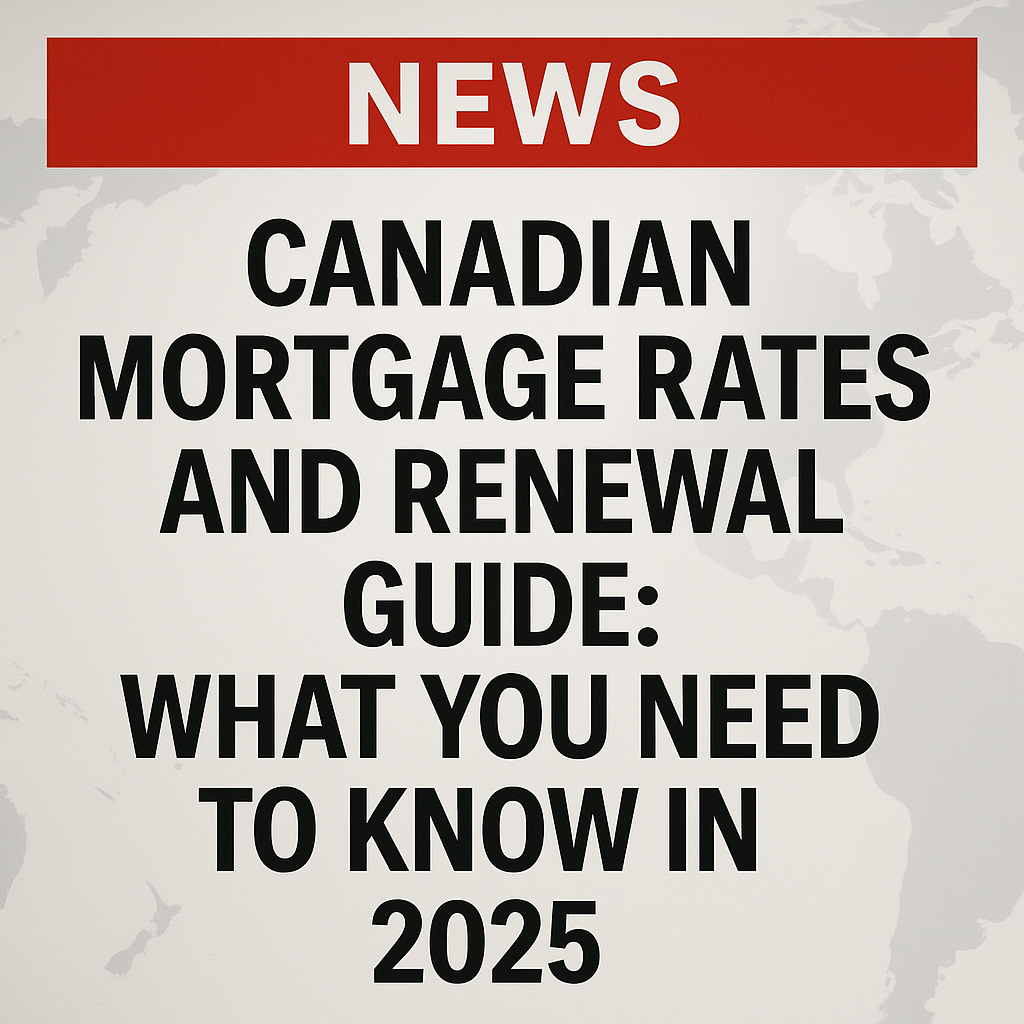In 2025, mortgage rates in Canada have seen significant fluctuations, largely driven by the Bank of Canada’s interest rate decisions, the economic ripple effects of US tariffs, and inflation. If you’re due for a mortgage renewal or considering refinancing, understanding these changes is essential to navigating your financial future.
What’s Happening with Mortgage Rates?
The Bank of Canada recently made a move to lower its policy rate, leading to a drop in both prime and variable mortgage rates. Meanwhile, fixed-rate mortgages, typically tied to bond yields, have also been gradually decreasing after a period of higher interest rates. However, the landscape for variable rates has been more unpredictable, as they’re directly influenced by changes in the Bank of Canada’s policy rate and the subsequent adjustments to lenders’ prime rates.
Big Canadian banks, including RBC, TD, BMO, Scotiabank, CIBC, National Bank, and Desjardins, have recently reduced their mortgage rate discounts, primarily due to concerns over tariff uncertainty and recession risks. As a result, high-ratio mortgage rates have dropped below the 4% mark, with typical 5-year fixed rates on conventional mortgages hovering around the mid-4% range, and variable rates slightly lower.
How Do Interest Rate Changes Affect You?
When mortgage rates rise, the cost of owning a home increases. Higher interest rates mean higher monthly payments, reducing affordability. On the flip side, when rates decrease, monthly payments become more affordable, sometimes causing home prices to climb as more buyers can afford higher payments.
The Bank of Canada plays a key role here. It sets the prime rate that Canadian banks use to determine variable mortgage rates. When the BoC raises rates to control inflation or stabilize the economy, it directly affects mortgage holders, especially those with adjustable-rate mortgages (ARMs). For those with variable-rate mortgages (VRMs), monthly payments might remain steady, but the proportion that goes toward principal versus interest will change based on interest rate fluctuations.
Choosing the Right Mortgage in 2025
With interest rates in flux, it’s crucial to pick the mortgage that aligns with your financial situation and risk tolerance.
-
Fixed vs. Variable Mortgages: Both fixed and variable mortgages offer predictable payments, but their advantages differ. Fixed mortgages give you certainty, as your payments stay the same throughout the term. On the other hand, variable mortgages typically come with a lower initial rate, providing savings in the early years, but they carry the risk of rising payments if interest rates go up.
-
Adjustable-Rate Mortgages (ARMs): These function like variable mortgages, but payments are periodically adjusted based on changes to the prime rate. While your payments will fluctuate with interest rates, you won’t face the risk of negative amortization.
-
Mortgage Pre-Approval: Getting pre-approved can lock in a rate or discount for a period, protecting you from potential rate hikes before your mortgage is finalized.
-
Managing Renewal Payment Shock: If you’re renewing at a higher interest rate than your previous mortgage, it could lead to significantly higher monthly payments. Refinancing or exploring other mortgage options might help manage this increase, especially if you need to adjust your amortization period.
Other Mortgage Options to Consider
Aside from fixed, variable, and adjustable-rate mortgages, there are other mortgage types to explore:
-
Open vs. Closed Mortgages: Open mortgages allow extra payments or early repayment without penalties. Closed mortgages offer lower interest rates but limit extra payments to a percentage of the original balance.
-
Short-term vs. Long-term Mortgages: Shorter-term mortgages (1-2 years) typically have lower rates but provide less stability, while longer-term mortgages (5-10 years) come with higher rates but more predictable payments. Interestingly, due to economic uncertainty caused by US tariffs, shorter-term rates have been higher than longer-term rates, as the market anticipates future stabilization.
-
Hybrid Mortgages: These combine different types of mortgage products, such as fixed and variable rates, along with home equity lines of credit (HELOCs). These hybrids allow you to balance risk and potential savings.
A blended mortgage is another option. It combines your current mortgage rate with a new, lower rate, helping you reduce interest costs without fully refinancing or incurring prepayment penalties. This can be done through various methods:
-
Blend and Extend: Lowers your rate and extends your mortgage term.
-
Blend to Term: Applies a lower rate to the remainder of your current term.
-
Blend and Increase: Lets you borrow more by adding to your mortgage balance at a blended rate.
What to Do If Your Lender Won’t Renew Your Mortgage
Rising mortgage delinquencies have made it harder for some Canadians to renew their mortgages. If your lender refuses to renew due to missed payments or a poor credit score, it may leave you with limited and more costly options. This situation, though rare, can be difficult to navigate, especially if your credit hasn’t improved enough to qualify for better terms.
If you find yourself in this predicament, there are several potential solutions:
-
Find a co-signer or guarantor.
-
Work on improving your credit score.
-
Consolidate your debts.
-
Explore refinancing or consider subprime lending.
-
As a last resort, selling or downsizing your home might be necessary.
Canadian Real Estate Market Trends
In Ontario, home prices have remained relatively stable through early 2025, with slight year-over-year growth. Cities like Toronto have seen an uptick in sales activity, driven by more listings and modest price increases. Ottawa continues to experience a balanced market, with consistent demand. In Hamilton and London, interest remains strong, as buyers look for more affordable options outside the Greater Toronto Area.
Across Canada, housing markets are showing signs of gradual recovery. Quebec’s market is stable, with Montreal experiencing steady demand and rising prices, particularly for single-family homes. Western Canada, especially Vancouver, faces ongoing affordability challenges, while Calgary and Edmonton are benefiting from relative affordability and strong local economies. Winnipeg’s market remains balanced with moderate price shifts.
Recent Mortgage Rule Changes
Several key changes are now affecting how Canadians qualify for mortgages:
-
Insured Mortgage Limit Increase: The insured mortgage limit has been raised from $1 million to $1.5 million, allowing you to buy homes up to this value with just a 5% down payment. This change opens up the market for higher-priced homes, particularly in Ontario.
-
Stress Test Removed for Mortgage Transfers: If you’re renewing your mortgage and switching lenders without changing the loan amount or amortization, you no longer need to pass the stress test, making it easier to find a better rate.
-
Income Requirements: To qualify for a mortgage, lenders typically use Gross Debt Service (GDS) and Total Debt Service (TDS) ratios. For example, to qualify for a $400,000 mortgage, your combined household income should fall between $87,300 and $110,400, depending on your loan terms and ratio.
What’s Next for Mortgage Rates?
Mortgage rate forecasts suggest that rates could ease in 2025, especially if the Bank of Canada reduces its policy rate. The policy rate currently sits at the upper end of the neutral range (2.25% – 3.25%), with cautious rate cuts expected throughout the year, potentially bringing it down to around 2.50% by the end of 2025.
While lower mortgage rates would be beneficial for homeowners renewing later this year, there is still potential for increases due to ongoing tariff risks or rising home prices, which could offset the benefits of rate cuts. With uncertainty looming, locking in a rate sooner rather than later might be a smart move, especially with over 200,000 mortgages set to mature in June.
As the economic landscape continues to shift, understanding the factors that influence mortgage rates can help you make informed decisions when renewing, refinancing, or purchasing a new home.
Ready to navigate the mortgage landscape in 2025? Contact nesto’s mortgage experts today for personalized advice tailored to your unique financial situation.



